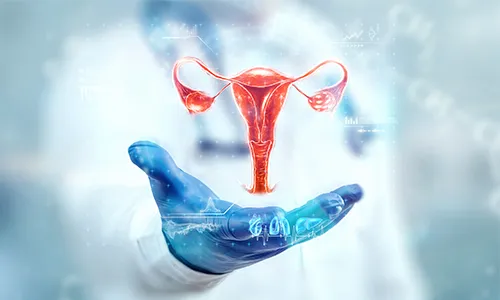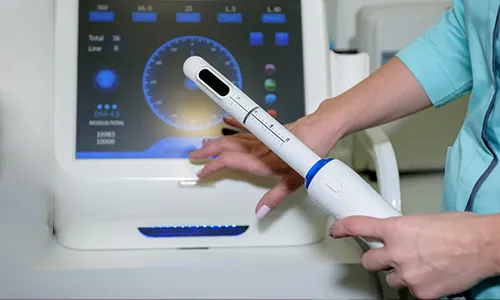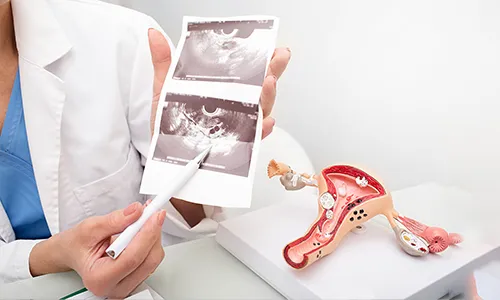

About Ovarian Cancer
Prior to recent research, it was thought that ovarian cancers solely developed in the ovaries, but it now appears that several ovarian cancers could actually develop in cells at the distal (farther) end of the fallopian tubes. The term “ovarian cancer” is frequently used to refer to malignancies that develop in the ovarian, fallopian tube, or peritoneal cells. The malignancies are treated similarly because they are closely related to one another.


Risk Factors & Prevention
Women of ages 50 and older are at a higher risk of having ovarian cancer.
Some risk factors are:
- Having an excessive weight
- Delayed childbearing or never experienced a full-term pregnancy
- Hormonal therapy following menopause
- Having ovarian cancer, breast cancer, or colorectal cancer in the family
- Smoking
How it can be prevented?
- Breastfeeding
- Child-bearing
- Birth control pills
- Procedures to remove the ovaries


Screening
Screening exams for Ovarian cancer help detect cancer at an early stage. The likelihood of successful treatment is increased by early diagnosis. 94% of patients with ovarian cancer who are diagnosed early survive the condition for more than 5 years.
Screening tests are as follows:
- Transvaginal ultrasound (TVUS)
- CA-125 blood test


Symptoms & Signs
- Bloating sensation
- Stomach (abdomen) or pelvic pain
- Difficulty eating or feeling satisfied quickly
- Urgency or frequency of urination
- Severe fatigue
- Experiencing a backache
- Constipation
- Stomach (belly) swelling accompanied by weight loss


Diagnosis
Ovarian cancer diagnostic tests determine whether you have the disease and how aggressive it may be.
Tools and tests include:
- Abdominal-pelvic examination
- CA-125 assay
- CEA
- Biopsy
- CT Chest + abdomen +pelvis
- PET-CT scan
- Transvaginal ultrasound


Sub-Types and Stages
- Epithelial ovarian tumor
- Borderline Epithelial Tumors
- Malignant epithelial ovarian tumors
- Serous carcinomas
- Clear cell carcinoma
- Mucinous carcinoma
- Endometrioid carcinoma
- Germ cell malignancies
- Dysgerminomas
- Teratoma
- Endodermal sinus tumors
- Embryonal carcinomas
- Granulosa cell tumors
- Fallopian tube cancer
- Primary Peritoneal cancer
Stages
Stage 1:
Only the ovaries are affected by the malignancy.
Stage 2:
The disease has spread to the fallopian tubes/ uterus.
Stage 3:
Lymph nodes along the main blood arteries (such as the aorta) in the abdomen and/or the peritoneum outside the pelvis have been affected by the malignancy.
Stage 4:
Cancer has spread to the liver, spleen, or other organs outside of the abdomen, such as the lymph nodes in the groin that are not inside the abdominal cavity.


Treatment Modalities
a. Surgical Oncology
- The majority of ovarian cancers are treated primarily with surgery. General health and the extent of cancer’s spread will determine how much surgery is needed.
It involves removal of the following:
- Salpingo-oophorectomy- Removal of fallopian tubes and ovaries Hysterectomy- The primary goal is to remove the uterus and, if necessary, any surrounding tissue. A partial hysterectomy is the medical term used when only the uterus is removed. A total hysterectomy involves the removal of the uterus and cervix.
- Dissection of lymph nodes and lymphadenectomy- Removal of lymph nodes from the paraortic and pelvic regions.
- Omentectomy- Removal of the thin tissue that covers the stomach and intestines.
- Cytoreduction or Debulking- Procedure for patients who have advanced ovarian/fallopian tube cancer.
b. Medical Oncology
- Chemotherapy- Chemotherapy kills cancer cells by using chemicals. Two or more drugs may be used for treating ovarian cancer.
- Targeted Therapy- For the treatment of advanced ovarian cancer, targeted medication therapy is frequently used in conjunction with chemotherapy.
- Immunotherapy- A medical therapy called immunotherapy supports the immune system’s ability to fight cancer. If the cancer is advanced and other treatments have failed for ovarian cancer, immunotherapy may be tried.
- Hormone therapy- If ovarian cancer has spread outside of the pelvic cavity and is advanced, hormone therapy may be used. It entails using medicine to reduce the body’s hormone levels.
c. Radiation Oncology
- To kill cancer cells, radiation therapy employs powerful energy beams like protons and X-rays. Radiation therapy is not commonly used for treating ovarian cancer.


Coping with Treatment
Along with the medical side effects of ovarian cancer therapy, patients also deal with the financial burden of cancer care and the emotional and social impacts. Talking to a counselor, or family member can help them to cope with treatment. MOC provides facility of psycho Onco-Counseling and Nutritional counseling to help patients.


Do’s & Don’ts During Treatment
Do’s
- Consume a balanced diet
- Keep a healthy weight
Don’ts
- Prevent potential muscle loss
- Avoid raw or undercooked meat or seafood
- Refrain from fatty, oily foods


Post-Treatment Support
Post-treatment ovarian cancer survivors can go through long-term side effects of surgery, chemotherapy, and hormonal therapy. They can also have symptoms such as Infection, fatigue, hair loss, poor appetite, nausea and vomiting, diarrhea, constipation, and nerve problems. Survivors require empathy, mental strength, and support from their families, they can also join ovarian cancer Post-Treatment Survivorship Support Groups.


Follow-ups Cancer Care Plan
Post-treatment one must request a follow-up treatment plan. Doctors provide a personalized treatment plan based on the type and stage of cancer.


Surveillance and monitoring for Signs & Symptoms of Recurrence
One aim of follow-up care is checking for a recurrence. One should never miss follow-up visits and never ignore any symptoms of recurrence. Because some cancer cells may remain undiscovered in the body in small locations that don’t respond to treatment, cancer can reoccur. A physician who is knowledgeable about your medical history can provide you with personalized information regarding your risk of recurrence during follow-up care.


FAQs
-
What symptoms indicate ovarian cancer?
Early stages of ovarian cancer do not exhibit any observable signs.
-
Where is ovarian cancer likely to spread?
Your surgeon will examine the tissues and organs nearby the suspicious ovarian tumor to see if cancer has spread there.
-
Is there a bump on your body from ovarian cancer?
An ovarian mass won’t be visible to you on your own. Your doctor may conduct an internal pelvic exam during a screening, which entails sticking a gloved hand into the genitalia.




